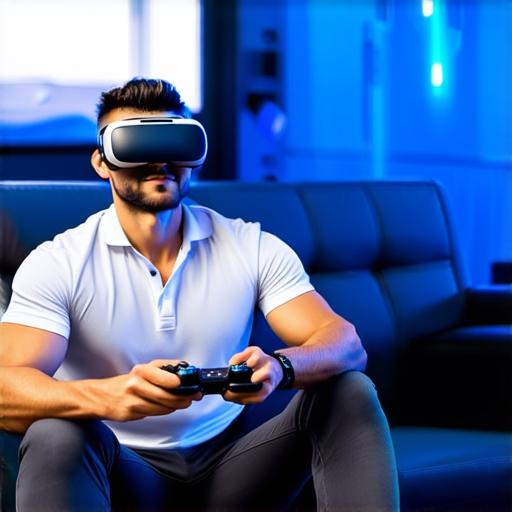Introduction: Virtual Reality in Therapy
Virtual reality (VR) technology has been around for decades but only recently has it gained significant attention in the field of mental health treatment. The immersive experience offered by VR can create a safe and controlled environment for individuals to confront their fears and anxieties, making it an effective tool that can supplement traditional therapy methods and help patients overcome their mental health challenges. In this expanded article, we will explore the benefits of VR in therapy and how it can enhance exposure therapy for various conditions.
Exposure Therapy: What is it?
Exposure therapy is a well-established treatment for various anxiety disorders, phobias, and PTSD. The basic idea behind exposure therapy is to expose individuals to the things they fear or anxiety-provoking situations in a controlled environment. This process helps patients develop coping skills and reduce their fear levels over time.
Virtual Reality Exposure Therapy: How it works?
Virtual reality exposure therapy involves creating a virtual environment that replicates the patient’s feared situation or object. Patients can then enter this virtual world and confront their fears in a safe and controlled setting. The therapist can guide the patient through the process, providing them with feedback and support as they learn to cope with their anxiety.
The Benefits of Virtual Reality Exposure Therapy
Virtual reality exposure therapy offers several benefits over traditional exposure therapy methods. Here are a few:
1. Customizable: Virtual reality technology allows therapists to create customized environments that replicate specific situations or objects that trigger the patient’s anxiety. This level of control can be difficult to achieve in real-life exposure therapy, making virtual reality exposure therapy an ideal option for some patients.
2. Repeatable: Patients can practice exposure therapy multiple times in a virtual environment, allowing them to gradually build up their exposure levels and reduce their anxiety over time. This repeatability is particularly useful for individuals with severe or persistent anxiety disorders.
3. Safe: Virtual reality exposure therapy is a safe and controlled environment where patients can confront their fears without the risk of harm. This makes it an ideal option for individuals who may not be able to face their anxieties in real life.
4. Effective: Research has shown that virtual reality exposure therapy can be as effective as traditional exposure therapy methods in reducing anxiety levels and improving mental health outcomes. In fact, some studies have shown that VR exposure therapy may be even more effective than traditional methods for certain conditions such as social anxiety disorder and PTSD.
5. Cost-Effective: Virtual reality exposure therapy can be a cost-effective option compared to traditional exposure therapy methods as it eliminates the need for expensive equipment or specialized settings.
6. Accessibility: Virtual reality technology can be accessed remotely, making it an ideal option for individuals who live in remote areas or have limited access to mental health services.
Case Studies: Virtual Reality Exposure Therapy in Action
Let’s take a look at a few examples of how virtual reality exposure therapy has been used to treat anxiety disorders and PTSD:
1. Anxiety Disorders: Virtual reality exposure therapy has been used successfully to treat various anxiety disorders such as social anxiety, specific phobias, and generalized anxiety disorder. For example, a study published in the Journal of Consulting and Clinical Psychology found that virtual reality exposure therapy was just as effective as traditional exposure therapy in reducing symptoms of social anxiety disorder. In another study, virtual reality exposure therapy was shown to be effective in reducing symptoms of specific phobias such as arachnophobia and acrophobia. Virtual reality exposure therapy has also been used successfully to treat panic disorder, a condition characterized by recurrent episodes of intense fear or discomfort that peak within minutes and includes at least four of the following symptoms: sweating, trembling, shaking, palpitations, nausea, dizziness, hot flashes, chest pain, shortness of breath, and chills or hot flashes.

2. PTSD: Virtual reality exposure therapy has been used successfully to treat post-traumatic stress disorder (PTSD), a mental health condition that can develop after experiencing or witnessing a traumatic event such as natural disasters, serious accidents, rape, war or combat, physical or sexual assault, or the sudden death of a loved one. Virtual reality exposure therapy has been shown to be effective in reducing symptoms of PTSD such as flashbacks, nightmares, avoidance, hyperarousal, and negative alterations in cognitive functioning, mood, or self-esteem.
3. Substance Abuse: Virtual reality exposure therapy has also been used successfully to treat substance abuse disorders. Virtual reality exposure therapy can be used to simulate situations that trigger cravings and provide individuals with coping strategies to manage them.
Summary
Virtual reality technology is an exciting tool that can enhance traditional therapy methods and help individuals overcome their mental health challenges. Virtual reality exposure therapy offers a safe and controlled environment for patients to confront their fears and anxieties, gradually building up their exposure levels and reducing their anxiety over time. With the ability to create customized environments and repeat exposures, virtual reality exposure therapy is an effective and efficient treatment option for various anxiety disorders and PTSD. As research continues to advance in this field, we can expect virtual reality technology to play an increasingly important role in mental health treatment.
